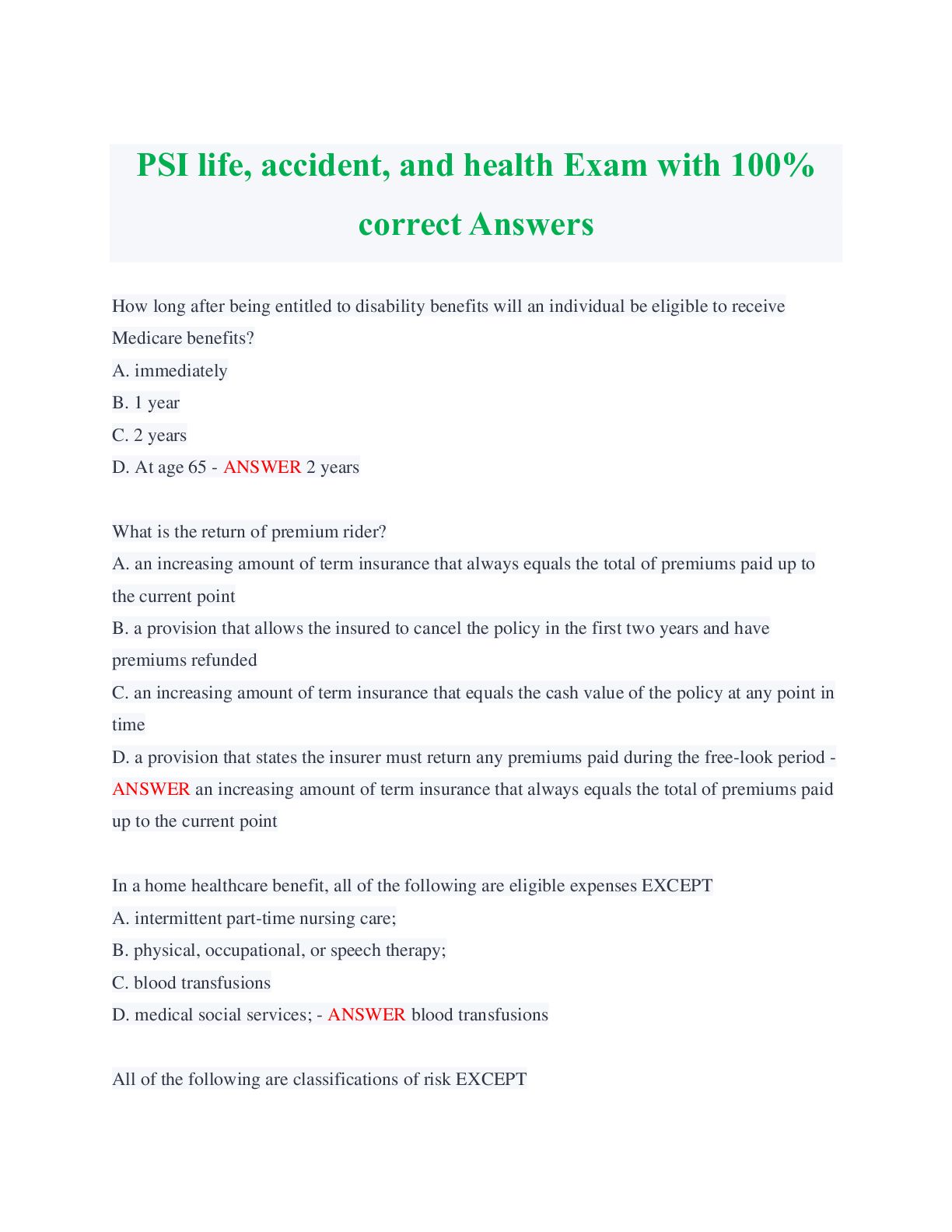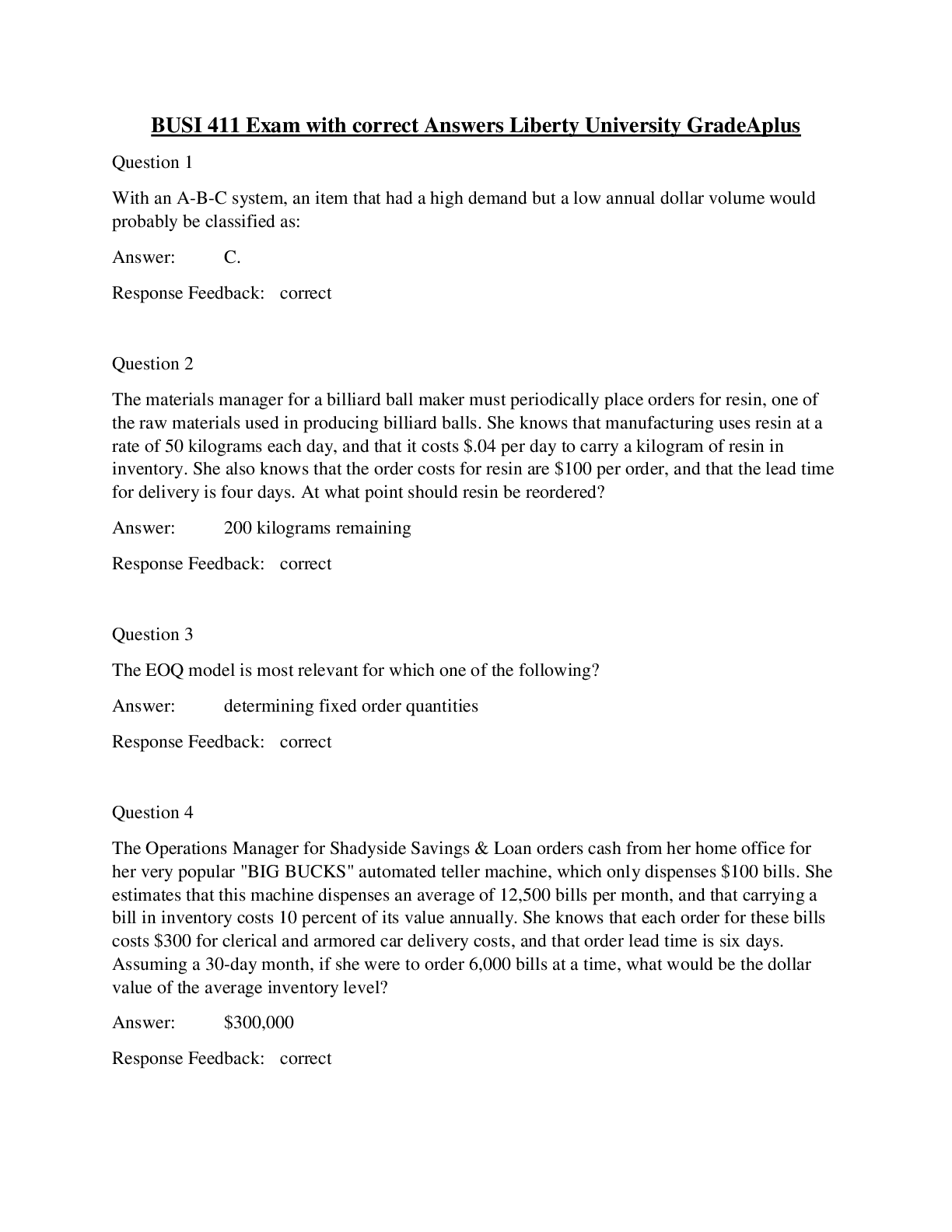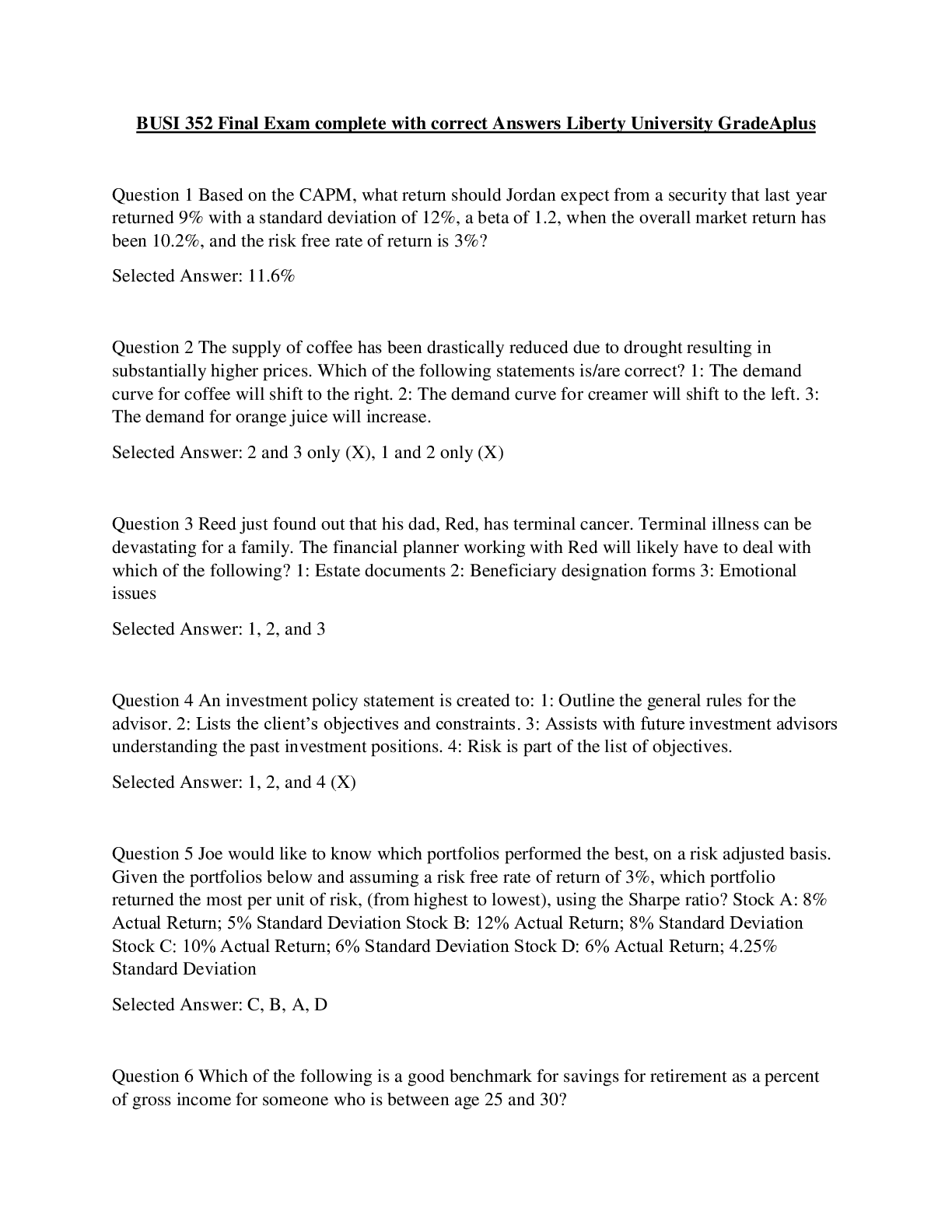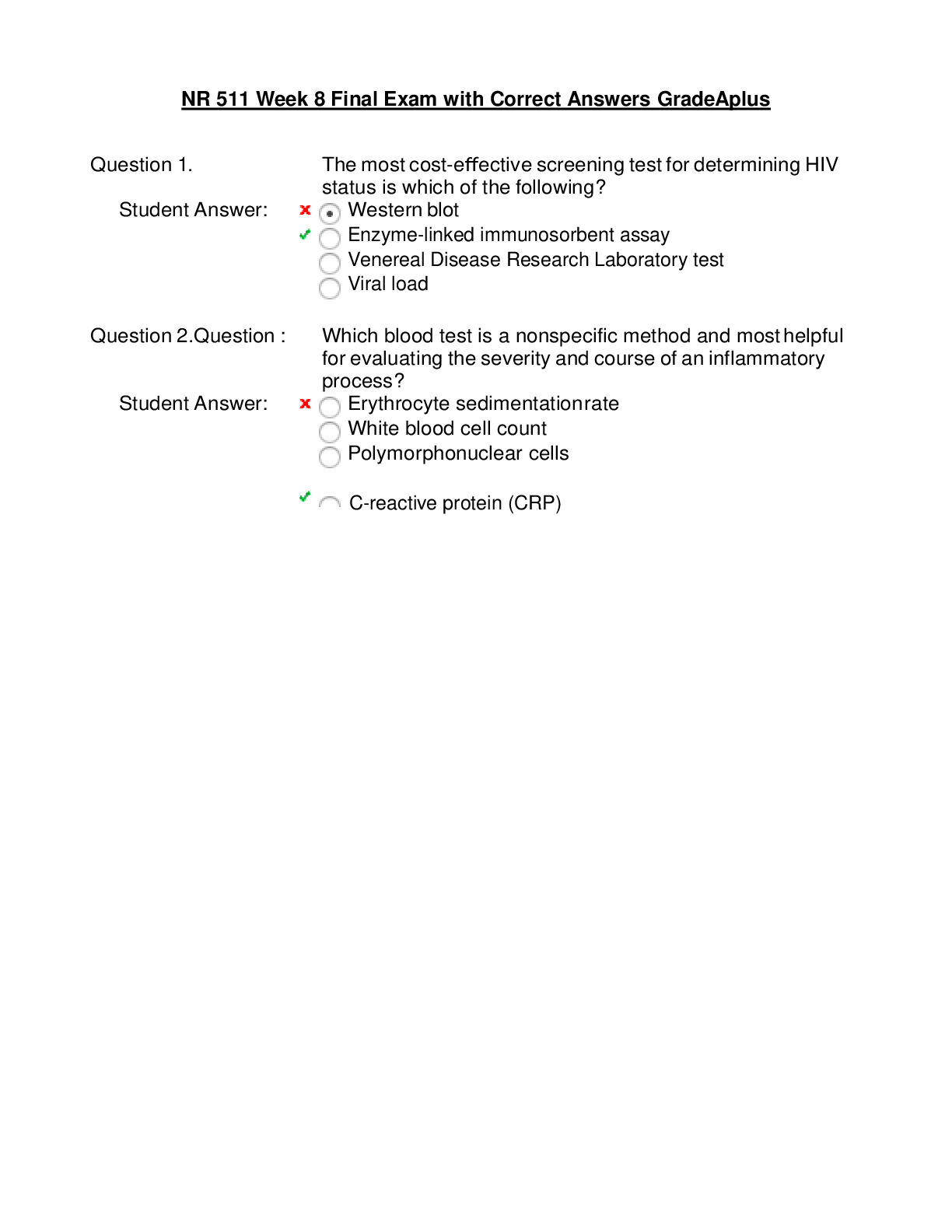Nursing 316 Exam #2 Questions with Correct Answers
Document Content and Description Below
functions of blood - ANSWER 1. transportation 2. regulation 3. protection transportation - ANSWER 1. O2 from lungs to cells, CO2 from cells to lungs 2. nutrients from GI to cells, waste from ce... ll for removal 3. brings molecules to cells regulation - ANSWER 1. pH 2. temp. 3. H20 content of cells protection - ANSWER 1. from hemorrhage via clothing mechanisms 2. from microbes and toxins (antibodies) characteristics of blood - ANSWER 1.liquid connective tissue 2. viscous 3. pH: 7.35-7.45 4. 8% of total body weight blood volume (males) - ANSWER 5-6ltrs. blood volume (females) - ANSWER 4-5ltrs. plasma - ANSWER 1. 91% H2O 2. 8% proteins 3. 1% other solutes proteins in plasma - ANSWER 1. albumins 2. globulins 3. fibrinogen 4. complement solutes in plasma - ANSWER 1. regulatory substances (enzymes, hormones) 2. nutrients 4. respiratory gasses 5. electrolytes formed elements - ANSWER 1. platelets 2. leukocytes 3. erythrocytes erythrocytes (RBCs) - ANSWER thin, non-nucleated biconcave discs biconcave discs - ANSWER 1. increase surface area for O2 diffusion 2. thin membrane increases diffusion of respiratory gasses reverse deformability - ANSWER 1. flexible membrane allows to squeeze through capillaries lifespan of erythrocytes - ANSWER ~120 days average amount of RBCs - ANSWER men: 5.4mil./mm3 women: 4.8mil/mm3 erythropoiesis - ANSWER hemocytoblast >reticulocyte >erythrocyte nutrients needed for erythropoiesis - ANSWER 1. proteins 2. iron 3. vitamins: C, E, niacin, riboflavin, folic acid, B12, B6 RBC during gestation - ANSWER 1. 1st several weeks, RBCs are formed in yolk sac 2. 2nd trimester, fetal RBCs are made in liver/spleen, bone marrow happens later 3. after birth, bone marrow takes over hypoxemia - ANSWER low O2 in blood hypoxia - ANSWER low O2 at tissue level life cycle of RBC - ANSWER 1. erythrocytes form in red bone marrow 2. circulate in bloodstream for 120 days 3. old RBCs are broken down in liver/spleen 4. heme is recycled 5. heme is converted to biliverdin >bilirubin, secreted in bile from liver 6. iron is transported by transferring and stored by ferritin in the liver 7. membranes proteins are broken into AA and used to make new erythrocytes hemoglobin to RBC - ANSWER 1 RBC=280 hemoglobin molecules composition of hemoglobin molecule - ANSWER 1. 4 hemoglobin complexes (iron containing pigment) 2. 2 pairs hemoglobin - ANSWER 1. 1 molecule carries 4 molecules of O2 on heme ring 2. all 4 molecules are bound to O2 Hemoglobin (Hgb) measures - ANSWER measures Hgb content of blood men: 14-18 g/dl women: 12-16 g/dl hematocrit (Hct) - ANSWER % of red cell mass in 100 ml men: 42-52% women: 37-47% MCV - ANSWER mean corpuscular volume MCHC - ANSWER means corpuscular hemoglobin MCV - ANSWER SLIDE 16 MCHC - ANSWER polycythemia vera - ANSWER associated with neoplastic transformation of bone marrow stem cells (myeloproliferative disorder) secondary polycythemia - ANSWER due to chronic hypoxemia, with a resultant increase in erythropoietin production relative polycythemia - ANSWER due to dehydration, which causes a spurious increase in the RBC count anemia - ANSWER -abnormally low Hgb, number of circulating RBCs, or both -a decrease in O2 carrying capacity of blood etiology of anemia - ANSWER 1. excessive blood loss 2. increase hemolysis (destruction) 3. decrease RBC production (nutritional, bone marrow failure, renal failure) 4. disorders of hemoglobin synthesis 5. dilutional (relative) compensatory mechanisms for anemia - ANSWER -selective tissue perfusion -increase o2 delivery -increase HR/CO/RR -increase erythropoiesis clinical representation of anemia - ANSWER decrease Hgb, decrease o2 carrying, hypoxemia, hypoxia general: fatigue, weakness, H/A, dizziness, visual disturbances, irritability, confusion respiratory: dyspnea on exertion cardiac: angina, tachycardia, palpitations, LV hypertrophy, orthostatic hypotension skin & mucous membranes: pallor/jaundice of skin; brittle finger nails, angular cheilitis, brittle hair; smooth tongue iron deficiency anemia - ANSWER 1. dietary deficiency of iron 2. loss of iron from blood loss 3. increase demand (pregnancy) clinical manifestations of iron deficiency anemia - ANSWER decreased H&H decreased RBCs decreased MCV decreased MCHC [Show More]
Last updated: 2 years ago
Preview 1 out of 5 pages
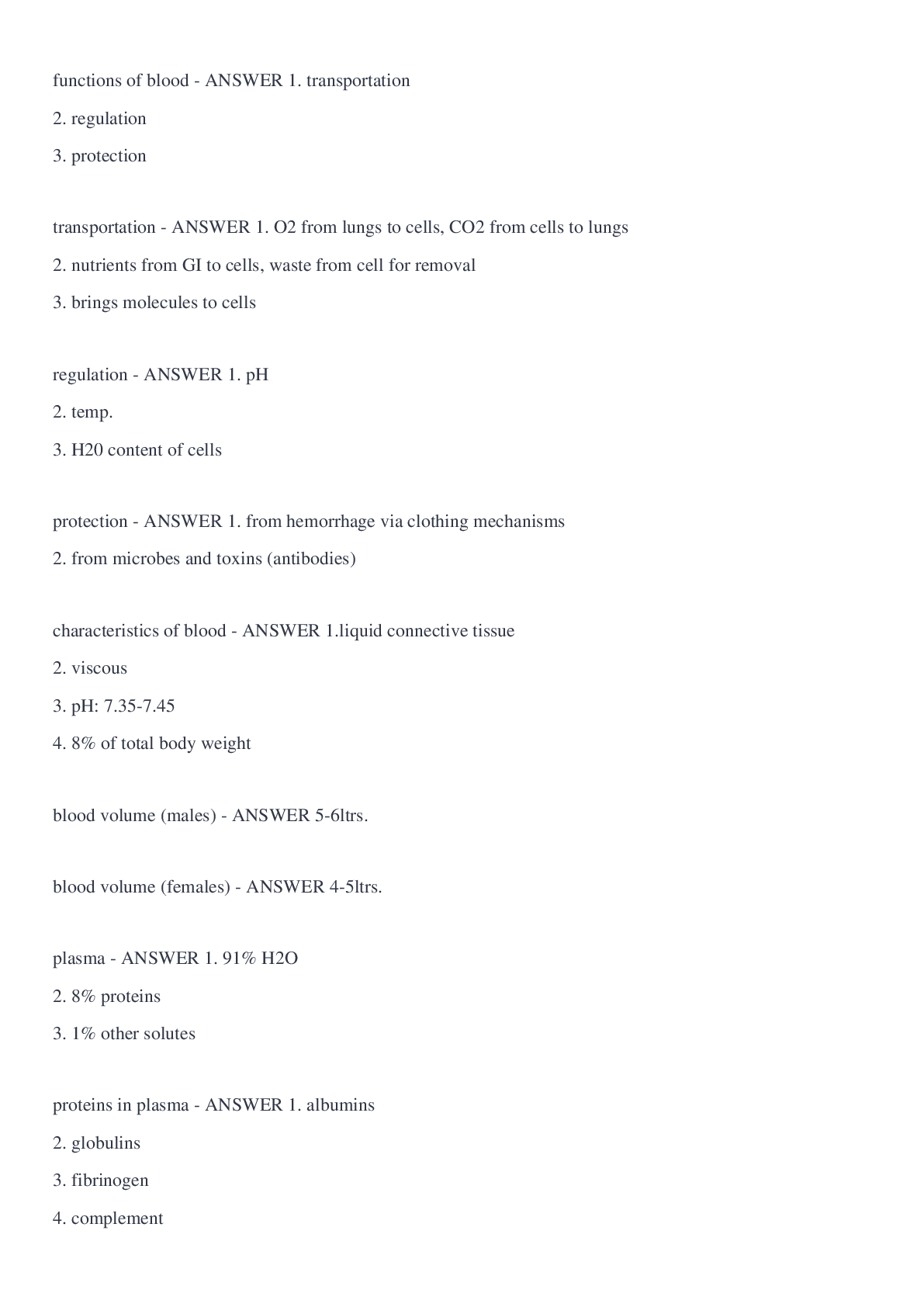
Buy this document to get the full access instantly
Instant Download Access after purchase
Buy NowInstant download
We Accept:

Reviews( 0 )
$6.00
Can't find what you want? Try our AI powered Search
Document information
Connected school, study & course
About the document
Uploaded On
Jul 27, 2022
Number of pages
5
Written in
Additional information
This document has been written for:
Uploaded
Jul 27, 2022
Downloads
0
Views
63



